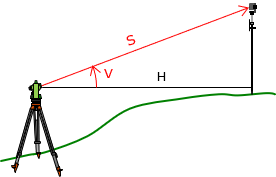2. What Do We Want To Know?
We don't make measuremetns just for the sake of using our equimpment (although it usually is fun to do so). We make measurements because we need to know something. We can divide our measurements into two camps depending on what we're after: Direct and Indirect.
a. Direct
A direct measurement is when we can use our equipment to determine the item we want without having to combine the measurement with others. The only computations involved would be to compensate errors or average multiple mweasurements.
For example, say we want to determine the distance between two property corners. Because the distance us short, we can directly measure it quickly using a steel tape, Figure B-4.
 |
| Figure B-4 Distance Between Property Corners |
Because the terrain is sloped, one end of the tape must be suspended which introduces a sag error in the measurement. Being conscientious surveyors, we measure the line multiple times.Once we correct for sag and average the measurements, we have what we wanted to know. No other measurements were necessary.
b. Indirect
Sometimes what we want to know can't be measured directly. We don't have an instrument that can determine a parcel's area from a single measurement; it's impossible to directly determine the height of an inacessible point, etc. Many of the things we need require separate measurements which must be mathematically combined.
Consider determining the height above ground of smokestack.We could maybe cllimd a short stack with a tape measure to directly measure its height. But anything over 100 ft becomes problematic because of tape length, safety, laibility, etc. We have to instead resort to measurement combinations and math, Figure B-5.
 |
| Figure B-5 Smokestack Height Determination |
Assuming the horizontal line throught the instrument intesects the smokestach at a right angle, to determine the height, Ht, requires three measurements::
H - horizontal distance to the smokestack
V - vertical angle to the smokestack top
A - height of the instrument center above the smokestack base
Computations are:
- Using H and V with trigonometry to get E
- Adding E to A to get Ht
Most of our surveying measurements are indirect: we genrally combine them with others to dftermine location, size, volunme, etc.
Some measurements we may think are direct are in fact indirect. One example is horizontal distance measurement with a total station. Usually all we do is sight a reflector, press a button, and the instrument reports the horizontal distance. But the instrument doesn't directly measure a horizontal distance even when its Line of Sight is horizontal. A total station measures slope distance and vertical angle, Figure B-6, and uses them to compute the horizontal distance.
 |
| Figure B-6 Horizontal Distance "Measurement" |
The error in the final quantity depends on measurement type. A direct measurement is only affected by the errors in that measurement - no outside influences. The error in an inderectly determined quantity depends on how the direct measurement errors interact.That's not a very simple or intuitive process in most cases because of the possible mathematical measurement conbimarions. These are discussed in depth in the II. Errors topic which is up next.